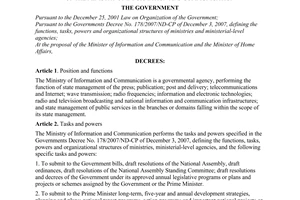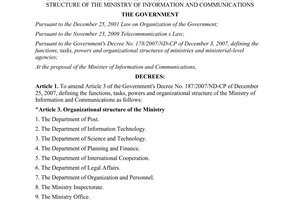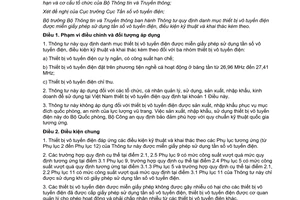Nội dung toàn văn Circular No. 03/2012/TT-BTTTT providing the list of radio devices exempt from
|
THE
MINISTRY OF INFORMATION AND COMMUNICATIONS |
THE
SOCIALIST REPUBLIC OF VIETNAM |
|
No. 03/2012/TT-BTTTT |
Hanoi, March 20, 2012 |
CIRCULAR
PROVIDING THE LIST OF RADIO DEVICES EXEMPT FROM RADIO FREQUENCY USE LICENSING AND ACCOMPANYING TECHNICAL AND OPERATION CONDITIONS
Pursuant to the November 23, 2009 Law on Radio Frequency;
Pursuant to the Government’s Decree No. 187/2007/ND-CP of December 25, 2007, defining the functions, tasks, powers and organizational structure of the Ministry of Information and Communications;
Pursuant to the Government’s Decree No. 50/2011/ND-CP of June 24, 2011, amending and supplementing the Government’s Decree No. 187/2007/ND-CP of December 25, 2007, defining the functions, tasks, powers and organizational structure of the Ministry of Information and Communications;
At the proposal of the director of the Radio Frequency Directorate;
The Minister of Information and Communications promulgates the circular providing the list of radio devices exempt from radio frequency use licensing and accompanying technical and operation conditions.
Article 1. Scope of regulation and subjects of application
1. This Circular provides the list of radio devices exempt from radio frequency use licensing and accompanying technical and operation conditions for three groups of radio devices:
a/ Short range devices with limited capacity;
b/ Devices placed on fishing vehicles with a frequency band between 26.96 MHz and 27.41 MHz;
c/ Radio receivers.
2. This Circular applies to organizations and persons that manage, use, manufacture, import or trade in for use in Vietnam radio devices provided in Clause 1 of this Article.
3. This Circular does not apply to radio devices which are manufactured or imported by armed forces for defense or security purposes. The manufacture, import and use of radio devices for these purposes shall be provided by the Ministry of National Defense or the Ministry of Public Security in conformity with corresponding national technical regulations.
Article 2. General conditions
1. Radio devices that satisfy technical and operation conditions provided in corresponding Appendices (No. 2 thru 12) to this Circular (not printed herein) are exempt from radio frequency use licensing.
2. Devices specified at Points 2.1 and 2.5 of Appendix 9 to this Circular with a capacity exceeding the corresponding level provided at Point 3.1 of Appendix 9 to this Circular, devices specified at Point 2.4 of Appendix 5 to this Circular with a capacity exceeding the corresponding level provided at Point 3.1.3 of Appendix 5 to this Circular, and devices specified at Points
2.1 and 2.2 of Appendix 11 to this Circular with a capacity exceeding the level provided at Point 3.1 of Appendix 11 to this Circular may be used only when having a license for radio frequency use.
3. License-free radio devices must not cause harmful interference to radio devices licensed for radio frequency use or radio devices licensed for operation by management agencies and must tolerate interference from other radio devices.
When a license-free radio device causes harmful interference, its owner shall immediately stop using it and may resume its operation only after having remedied such interference.
4. License-free radio devices must tolerate interference caused by devices using radio frequency energy for industrial, scientific and medical (ISM) purposes when they use of the following ISM frequency bands:
a/ Frequency band 13.553 ÷ 13.567 MHz;
b/ Frequency band 26.957 ÷ 27.283 MHz;
c/ Frequency band 40.66 ÷ 40.70 MHz;
d/ Frequency band 2400 ÷ 2483.5 MHz;
e/ Frequency band 5725 ÷ 5875 MHz;
f/ Frequency band 24000 ÷ 24500 MHz.
5. Manufacturers and importers of the radio devices provided in Clause 1, Article 1 of this Circular shall announce and assure their devices’ conformity with technical and operation conditions provided in corresponding Appendices (No. 2 thru 12) to this Circular.
6. The manufacture and import of radio devices exempt from radio frequency use licensing must also comply with the laws on import and regulation conformity certification and announcement.
Article 3. Implementation provisions
1. This Circular takes effect on May 10, 2012.
2. To annul the Information and Communications Minister’s Circular No.36/2009/TT-BTTTT of December 3, 2009, providing technical and operation conditions for conditional use of short range radio devices, and the Post and Telematics Minister’s Decision No. 09/2006/QD-BBCVT of April 10, 2006, providing technical and operation conditions for conditional use of radio devices placed on fishing vehicles.
3. Radio devices used before the effective date of this Circular which fail to comply with this Circular may operate no longer than 3 years after the effective date of this Circular or must not operate if causing harmful interference to lawfully operating radio devices and radio device systems.
4. The chief of the Ministry Office, the director of the Radio Frequency Directorate, heads of agencies and units under the Ministry of Information and Communications and related organizations and persons shall implement this Circular.
5. Any problems arising in the course of implementation should be promptly reported to the Ministry of Information and Communications for guidance or consideration and revision.
|
|
MINISTER
OF INFORMATION AND COMMUNICATIONS |
APPENDIX 1
LIST
OF RADIO DEVICES EXEMPT FROM RADIO FREQUENCY USE LICENSING
(To the Information and Communications Ministry's Circular
No.03/2012/TT-BTTTT of March 20, 2012)
|
No. |
Radio devices and applications |
Conditions on frequency and radiation limit |
Technical and operation conditions for each specific radio device |
|
1 |
General short range radio devices and applications |
Appendix 2 |
- |
|
2 |
Wireless telephone |
Appendix 3 |
|
|
3 |
Medical Implant Communication Service (MICS) and Medical Implant Telemetry System (MITS) |
Appendix 4 |
|
|
4 |
Radio Frequency Identification (RFID) device |
Appendix 5 |
|
|
5 |
Radio warning and detecting device |
Appendix 6 |
|
|
6 |
Wireless audio device |
Appendix 7 |
|
|
7 |
Remote control radio device |
Appendix 8 |
|
|
8 |
Wireless local area network (WLAN) |
Appendix 9 |
|
|
9 |
Radio telemetry device |
Appendix 10 |
|
|
10 |
Wireless video device |
Appendix 11 |
|
|
11 |
Radio devices placed on fishing vehicles1 |
Appendix 12 |
|
|
12 |
Radio receiver |
- |
- |
___________________
1 Fishing vehicles include fishing vessels or boats and other mobile or immobile vehicles at sea used to fish, process, culture or collect aquatic products, provide logistic services, or survey, explore, inspect, control or protect aquatic resources.-
APPENDIX 10
TECHNICAL
AND OPERATION CONDITIONS OF RADIO TELEMETRY DEVICES EXEMPT FROM RADIO FREQUENCY
USE LICENSING
(Enclosed with the Ministry of Information and Communications’ Circular No.
03/2012/TT-BTTTT dated March 2012)
1) Definition
Radio telemetry device is the device which automatically displays or records measurements and controls functions of other equipment via radio interface.
Radio telemetry devices shall not be subjected to radio frequency use licensing when they operate in the frequency bands prescribed in Point 2 of this Annex and meet the conditions prescribed in Point 3 of this Annex.
2) Frequency band conditions
Radio telemetry devices to be used shall operate in following frequency bands:
2.1. 26.957 ÷ 27.283 MHz
2.2. 29.70 ÷ 30.00 MHz
2.3. 40.50 ÷ 41.00 MHz (for medical and biological applications)
2.4. 216 ÷ 217 MHz (for medical and biological applications)
2.5. 433.05 ÷ 434.79 MHz
2.6. 24 ÷ 24.25 MHz
3) Emission conditions
3.1. Effective radiated power: Effective radiated power shall not be greater than the value corresponding to following bands:
3.1.1. 100 mW ERP corresponding to bands 26.957 ÷ 27.283 MHz; 29.7 ÷ 30.0 MHz.
3.1.2. 0.01 mW ERP corresponding to bands 40.50 ÷ 41.00 MHz; 216 ÷ 217 MHz.
3.1.3. 10 mW ERP corresponding to bands 433.05 ÷ 434.79 MHz.
3.1.4. 100mW EIRP corresponding to bands 24 ÷ 24.25 GHz
3.2. Spurious emissions:
3.2.1. For radio telemetry devices operating in the bands 26.957 ÷ 27.283 MHz; 29.7 ÷ 30.0 MHz; 216 ÷ 217 MHz; 433.05 ÷ 434.79 MHz: Attenuation of spurious emissions compared with effective radiated power is not smaller than 40 dBc at the transmitter’s output.
3.2.2. For radio telemetry devices operating in 40.50 ÷ 41.00 MHz band: Attenuation of spurious emissions compared with effective radiated power is not smaller than 32 dBc at 3m distance.
3.2.3. For radio telemetry devices operating in 24÷ 24.25 GHz band, spurious emission power level shall not exceed following respective value:
- In the bands 47 MHz ≤ f ≤ 74 MHz; 87.5 MHz ≤ f ≤ 118 MHz; 174 MHz ≤ f ≤ 230 MHz; 470 MHz ≤ f ≤ 862 MHz:
+ Operation mode: Spurious emission power does not exceed 4 nW.
+ Idle mode: Spurious emission power does not exceed 2 nW.
- In other bands smaller than 1000 MHz:
+ Operation mode: Spurious emission power does not exceed 250 nW.
+ Idle mode: Spurious emission power does not exceed 2 nW.
- In other bands greater than 1000 MHz:
+ Operation mode: Spurious emission power does not exceed 1 nW.
+ Idle mode: Spurious emission power does not exceed 20 nW.



